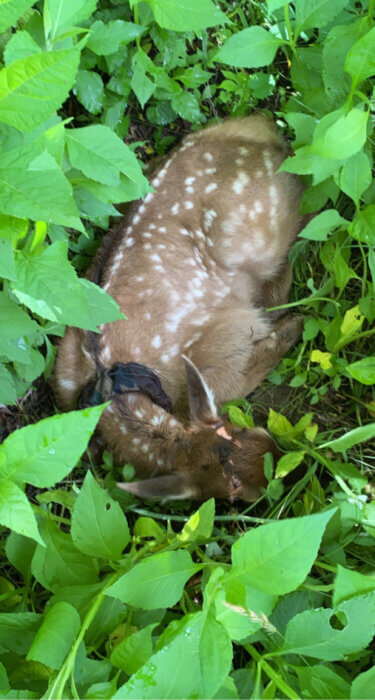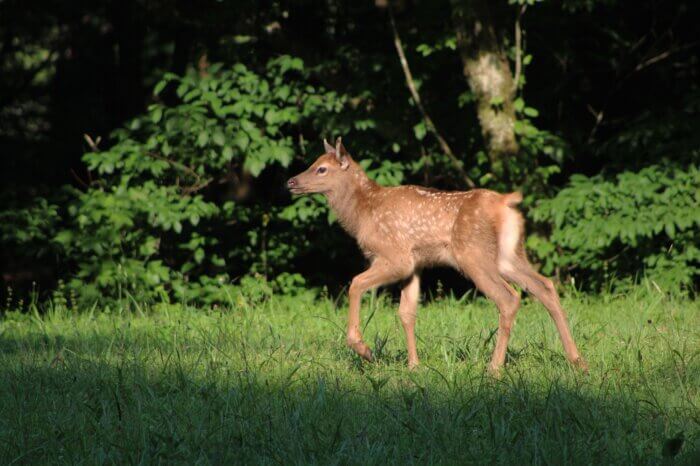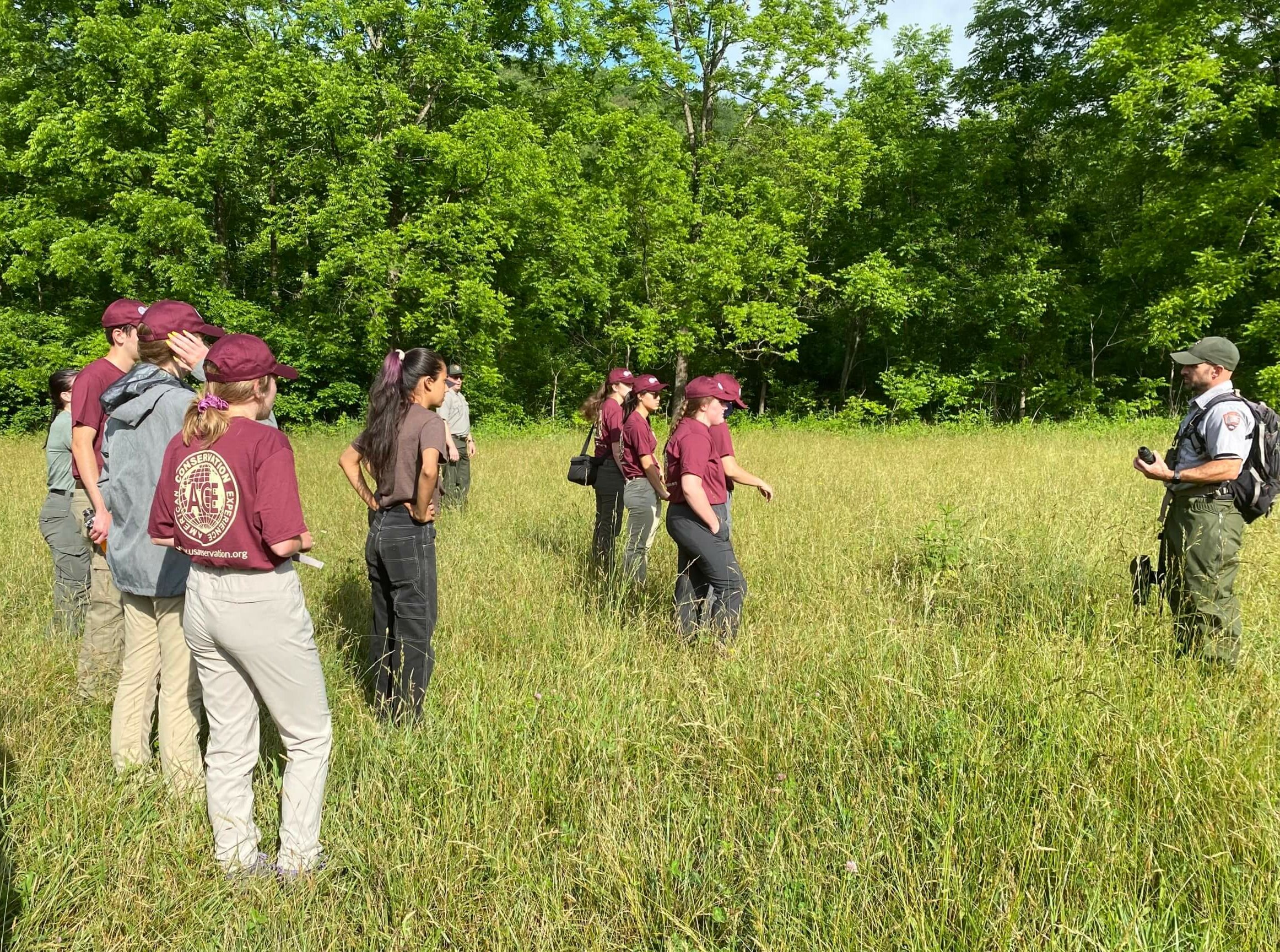The Great Smoky Mountains National Park high school intern program provides the opportunity for high school students from communities near the park to spend six weeks during the summer learning about the park and park careers. In this paid internship, students from North Carolina and Tennessee work with GSMNP staff on a wide range of park projects, from clearing trails to conducting research of wildlife. Phoebe Carnes, a senior at Swain County High School, shares the interns’ experience of learning about elk in the park.
by Phoebe Carnes
Guest blogger
Swain County (North Carolina) High School senior
It was around 7:30 in the morning when we arrived at the Oconaluftee Visitor Center to begin the much-anticipated Wildlife Day of our internship.

Early morning mist still blanketed the field where a small herd of five or so elk grazed, a reassuring sign that we just might find what we were looking for.
We soon drove to our chosen location, an area near the Visitor Center known for its elk activity.
There, we met up with Joe Yarkovich, one of the park’s wildlife biologists, to discuss our plan for the day. A female and her calf had been spotted in the area only an hour or so before our arrival, and it was our hope that we could locate the youngster and fit it with a radio collar.
Yarkovich explained the importance of elk in our mountains, while also giving us a brief history of elk reintroduction and the research the Park continues to engage in.
After two groups of 25 and 27 elk were brought to Cataloochee Valley in 2001 and 2002, respectively, the herd has grown to an impressive 200 individuals. It didn’t take long for a few stragglers to make their way to Oconaluftee, and it was there we hoped to assist the Park in their preservation efforts.
Search for elk calf
With new knowledge and growing enthusiasm, we made our way out into the field, all sixteen of us spreading ourselves out along the forest’s edge.
By forming a line, we ensured that no spot would be overlooked. The tall grass made it difficult to see, but it was the perfect habitat for a newborn elk calf to hide.

After only a few minutes of searching, we spotted a large cow (female elk) up ahead. She returned our gaze with a wary stare, ears perked forward and head raised.
Yarkovich went ahead of us and plucked a blade of grass, blowing on it at such an angle that it sounded like the bleat of a calf. The cow responded by whipping her head in his direction, her attention grabbed.
While it wasn’t definitive, her behavior told us that there could possibly be a baby nearby.
We continued on, keeping a close eye on the female. As we rounded the treeline, Joe suddenly stopped, ordering for the rest of us to do the same. He pointed to a spot in the thick foliage.
Though it was barely visible through the leaves and budding flowers, the large ears and spotted coat were unmistakable. We had found an elk calf!
We began to circle it, careful as to not cause too much disruption. Calves are able to run a mere fifteen minutes after birth, and if we were to spook it, the baby elk could be gone in the blink of an eye.
Luckily for us, the calf was only a week or so old, and its first instinct was to lie as still as possible as opposed to flee.
Our biggest concern in this case was the mother, who was glaring at us from the other side of the trees. As long as her baby didn’t squeal, she seemed content with monitoring us.
We closed in, each of us was only an arm’s length from the young elk. As we stood over the calf, which barely moved a muscle, we realized that it was one the biologist’s had already collared.
Despite this, I don’t believe any of us were disappointed. The opportunity to get so close to a gorgeous animal was rewarding, and we left the calf with a sense of wonder.
World’s Most Advanced Game of Hide-and-Seek
After leaving the calf and its mother, we got to practice radio telemetry. This is a tracking method used by researchers across the globe, especially in places that are difficult to traverse. Essentially, we had an antenna that picked up particular frequencies (like those given off by elk collars).

The beeping got louder as we swung it in the right direction, and so it was a matter of accurately pinpointing the location of our target. In this case, it was two interns hiding in the woods with an unused elk tracking collar.
While it wasn’t a difficult task once we got the hang of it, the mountains and trees certainly made it tougher to properly figure out the location of our target. Once we locked in on the beeping, it was easy to find the other interns behind the base of a tree.
GSMNP Internship
Throughout the duration of this internship, I have come to appreciate the Great Smoky Mountains National Park and all of those who strive to maintain it. From the biologists to the maintenance crew, each individual is a part of a well-oiled machine.

I found myself enjoying nearly every aspect of being a Park Ranger. Even digging holes and putting in locust fence posts at the Oconaluftee Visitor Center was enjoyable!
The internship is an opportunity that I know I’ll be forever grateful for.
Not only did I learn and grow as an aspiring wildlife biologist, but I found a tight-knit community of nature-lovers and established lifelong friendships.
My thanks cannot be put into a single paragraph or even a single post, and so I have opted to continue learning and enjoying America’s most visited and biodiverse National Park, sharing my newfound passion and knowledge with anyone who will listen.
Partners And Funders
Funding for the internship program comes from a variety of sources — the National Park Foundation, the National Environmental Education Foundation, and the National Park Service’s Youth Partnership Program, Friends of the Smokies pays for supplies and for the program’s graduation event. The Tremont Institute provides some staff members to help with the program.
Partner organizations include the Boys and Girls Club, American Conservation Experience (ACE), CAC AmeriCorps, and the Great Smoky Mountains Institute at Tremont.
